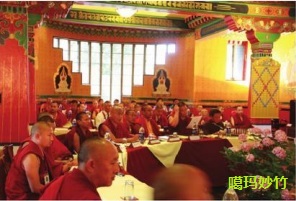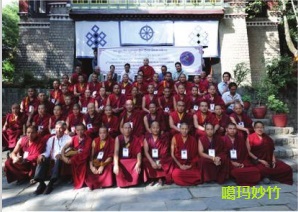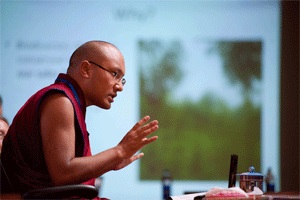法王新闻 | 2012年06月
『第4届噶举環保会议』災難防備计划•第2天
『The Fourth Kagyu Conference On Environmental Protection』Disaster Preparedness•Day Two
༄༅།། བཀའ་བརྒྱུད་པའི་རང་བྱུང་ཁོར་ཡུག་སྲུང་སྐྱོབ་ཀྱི་ཚོགས་འདུ་ཐེངས་བཞི་པ། ཉིན་གཉིས།

時間:2012年06月06日 06 June, 2012
地點:地點:印度 達蘭沙拉 羅布林卡 Norbulingkha, Dharamsala, India
Day Two began with a science tutorial by Dekila Chungyalpa, the conference facilitator, for the gathered monks and nuns.
環境保護研討會第二天議程的首場演說,為此次會議的協調人德其樂.瓊嘉巴(Dekila Chungyalpa)的環保科學簡介。
Bringing the environmental concern to a local level, the second presentation was delivered by Jigme Norbu from the Environment and Development Desk of DIIR.
第二場演說是西藏流亡政府「環境與發展政策研究室」的吉美.諾布(Jigme Norbu)的發言。
In order to engage the audience, the third presenter, Abdesh Gangwar from the Center for Environmental Education, an Indian NGO, used a game to enliven the energy of the room.
為了讓與會代表更有參與感,第三場演講的演說者印度非政府機構「環保教育中心」的阿得須.岡瓦(Abdesh Gangwar),特別採取寓教於樂的遊戲方式來提升學習的興致。
The final presentation of the day was by Tenzing Norsang from the Wildlife Trust of India, who gave an impassioned talk about the importance of endangered species such as the tigers, snow leopards, Tibetan antelope and other important species in the region.
上午會議最後一場的演講,為由來自「印度野生動物信託」的天津.諾桑(Tenzin Norsang)所發表的關於瀕臨絕種的動物之重要性的一場惻動人心的演說。這些瀕臨絕種的動物包括有老虎、雪豹、西藏水牛、以及其它當地的重要生物。

In the afternoon, audience members were asked to identify natural disaster risks in their own monastic location and then to form groups based on these risks. The three groups that formed were
整個下午的議程為分組討論。大會首先要求會眾辨識出自己寺院所在地的潛在自然災害,然後按照災害的種類而形成討論小組。最後組成的三個小組分別為:

They devoted the rest of the afternoon to discuss their individual experiences during such occurrences, what kind of survival methods were successful or not, and how they thought the environment and ecosystem services around them could have played a beneficial or non-beneficial role in that risk. The discussion ranged from energetic to emotional, as some monks and nuns described the chaos from the 2011 earthquake in northeast India and Nepal as buildings buckled and collapsed around them. One monk said that providing practical training of what to do during a natural disaster and how to be prepared in the future would be of great benefit to him and his monastery and would help ease many of their fears.
小組成員討論當此天然災害發生時,他們個人的經驗、以及那些救災方法是否成功,並且他們認為周遭的環境與生態系統的服務所扮演的角色是否有益。部份僧眾與尼師談到2011年發生在印度東北部和尼泊爾的地震,在談到建築物在他們身邊傾毀倒塌時,瞬間會場的氣氛由慷慨激昂到一片唏噓。一位僧人表示,提供天然災害發生時的實用救災訓練,以及對未來災害的預備措施,這會對他自身和自己的寺院有很大的益處,並有助於緩解他們對災害的諸多恐懼。
网页修改记录:2024年07月18日,新建网页。
